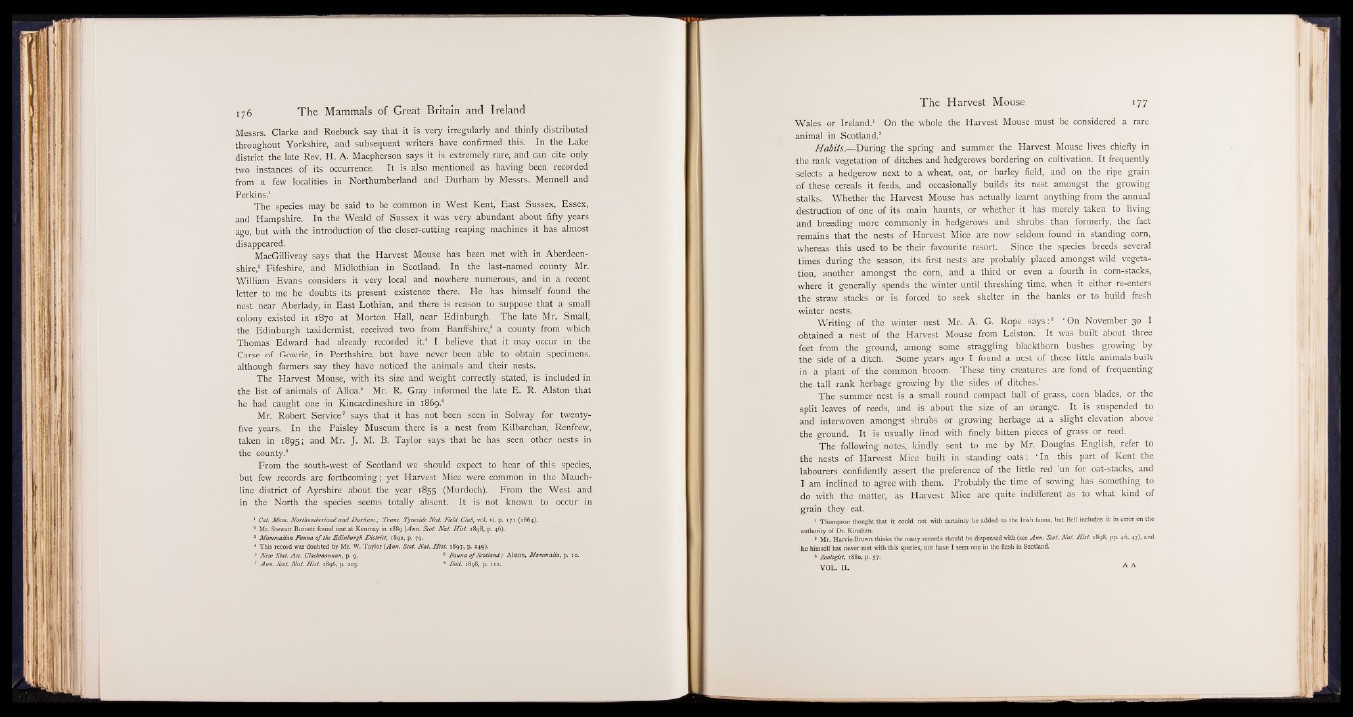
Messrs. Clarke and Roebuck say that it is very irregularly and thinly distributed
throughout Yorkshire, and subsequent writers have confirmed this. In the Lake
district the late Rev. H. A. Macpherson says it is extremely rare, and can cite only
two Instances of its occurrence. It is also mentioned as having been recorded
from a few localities in Northumberland and Durham by Messrs. Mennell and
Perkins.1
The species may be said to be common in West Kent, East Sussex, Essex,
and Hampshire. In the Weald of Sussex it was very abundant about fifty years
ago, but with the introduction of the closer-cutting reaping machines it has almost
disappeared.
MacGillivray says that the Harvest Mouse has been met with in Aberdeenshire,
2 Fifeshire, and Midlothian in Scotland. In the last-named county Mr.
William Evans considers it very local and nowhere numerous, and in a recent
letter to me he doubts its present existence there. He has himself found the
nest near Aberlady, in East Lothian, and there is reason to suppose that a small
colony existed in 1870 at Morton Hall, near Edinburgh. The late Mr. Small,
the Edinburgh taxidermist, received two from Banffshire,8 a county from which
Thomas Edward had already recorded it.4 I believe that it may occur in the
Carse of Gowrie, in Perthshire, but have never been able to obtain specimens,
although farmers say they have noticed the animals and their nests.
The Harvest Mouse, with its size and weight correctly stated, is included in
the list of animals of Alloa.6 Mr. R. Gray informed the late E . R. Alston that
he had caught one in Kincardineshire in 1869.6
Mr. Robert Service7 says that it has not been seen in Solway for twenty-
five years. In the Paisley Museum there is a nest from Kilbarchan, Renfrew,
taken in 1895; and Mr. J . M. B. Taylor says that he has seen other nests in
the county.8
From the south-west of Scotland we should expect to hear of this species,
but few records are forthcoming; yet Harvest Mice were common in the Mauchline
district of Ayrshire about the year 1855 (Murdoch). From the West and
in the North the species seems totally absent. It is not known to occur in
1 Cat. Mam. Northumberland and Durham ; Trans. Tyneside N at. F ield Club, vol. vi. p. 17 1 (1864).
2 Mr. Stewart Burnett found one at Kenmay in 1889 {Ann. Scot. N at. H ist. 1898, p. 46).
3 Mammalian Fauna o f the Edinburgh D istrict, 1892, p. 79.
4 This record was doubted by Mr. W. Taylor (Ann. Scot. N at. H ist. 1897, p. 249).
6 New Staf. Acc. Clackmannan, p. 9. 6 Fauna o f Scotland; Alston, Mammalia, p. 10.
7 Ann. Scot. N at. H ist. 1896, p. 205. * Ib id . 1898, p. 112 .
Wales or Ireland.1 On the whole the Harvest Mouse must be considered a rare
animal in Scotland.2
H ab its.—During the spring and summer the Harvest Mouse lives chiefly in
the rank vegetation of ditches and hedgerows bordering on cultivation. It frequently
selects a hedgerow next to a wheat, oat, or barley field, and on the ripe grain
of these cereals it feeds, and occasionally builds its nest amongst the growing
stalks. Whether the Harvest Mouse has actually learnt anything from the annual
destruction of one of its main haunts, or whether it has merely taken to living
and breeding more commonly in hedgerows and shrubs than formerly, the fact
remains that the nests of Harvest Mice are now seldom found in standing corn,
whereas this used to be their favourite resort. Since the species breeds several
times during the season, its first nests are probably placed amongst wild vegetation,
another amongst the corn, and a third or even a fourth in corn-stacks,
where it generally spends the winter until threshing time, when it either re-enters
the straw stacks or is forced to seek shelter in the banks or to build fresh
winter nests.
Writing of the winter nest Mr. A. G. Rope s a y s :8 ‘ On November 30 I
obtained a nest of the Harvest Mouse from Leiston. It was built about three
feet from the ground, among some straggling blackthorn bushes growing by
the side of a ditch. Some years ago I found a nest of these little animals built
in a plant of the common broom. These tiny creatures are fond of frequenting
the tall rank herbage growing by the sides of ditches.’
The summer nest is a small round compact ball of grass, corn blades, or the
split leaves of reeds, and is about the size of an orange. It is suspended to
and interwoven amongst shrubs or growing herbage at a slight elevation above
the ground. It is usually lined with finely bitten pieces of grass or reed.
The following notes, kindly sent to me by Mr. Douglas English, refer to
the nests of Harvest Mice built in standing oats: ‘ In this part of Kent the
labourers confidently assert the preference of the little red ’un for oat-stacks, and
I am inclined to agree with them. Probably the time of sowing has something to
do with the matter, as Harvest Mice are quite indifferent as to what kind of
grain they eat.
1 Thompson thought that it could not with certainty be added to the Irish fauna, but Bell includes it in error on the
authority of Dr. Kinahan.
2 Mr. Harvie-Brown thinks the many records should be dispensed with (see Ann. Scot. Nat. Hist. 1S9S, pp. 46, 47), and
he himself has never met with this species, nor have I seen one in the flesh in Scotland.
3 Zoologist; 1880, p. 57.
VOL. II. A A